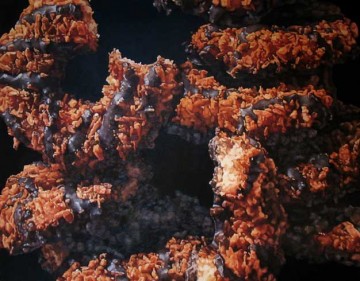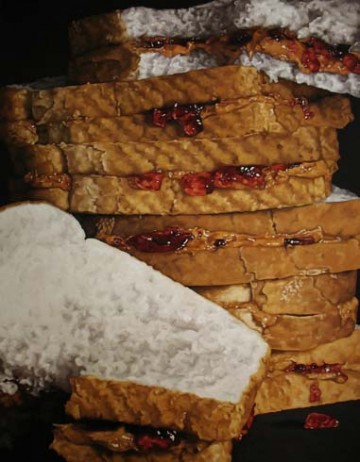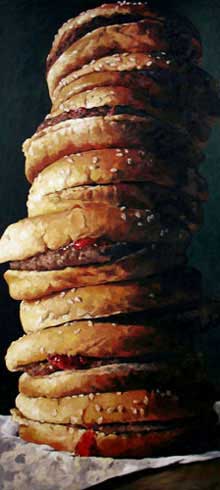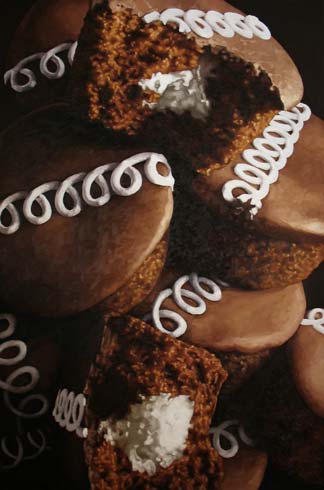
Pamela Johnson, "Girl Scout Cookies," 2008. Oil on canvas, 54 x 68 in. Courtesy of Pamela Johnson.
I asked Pamela Johnson about other people who had encountered the massive Girl Scout cookies or cheese and cracker Handi Snacks™, eager to know how they were received and processed through various memory banks, personal histories and social filters, and curious about what ideas came out the other side.
Some people totally get it and they usually get a bit of an embarrassed laugh out of the junk food. Then there is the large number of people that love the work because they love cupcakes, Pop Tarts™, or P.B.&J’s. At least their interest in the work opens the door to a conversation of why I paint huge piles of junk food. I think most people understand the excess of our culture, even if they are choosing to embrace that excess instead of being disturbed by it. I do get a lot of the ‘I know it is bad but I can’t resist’ sentiment. All of it makes me wonder if I need to push the work a little further.

Pamela Johnson, "PB&J II," 2009. Oil on canvss, 58 x 44 in. Courtesy of Pamela Johnson.

Pamela Johnson, "Burgers I," 2006. Oil on canvas, 72 x 32 in. Courtesy of Pamela Johnson.
The first time I saw the paintings, at The Artist Project in April of 2008 as part of Artropolis, Johnson told me that they even elicited nostalgia, memories of when mom would pack a cupcake or Ding Dong™ in a sack lunch and send you off with an idyllic Americana nudge out the door. Admittedly the sound of cellophane calls my own kidhood to the surface because I too used to get Little Debbie Oatmeal Creme Pies™ in my lunch, or, on special days, Swiss Cake Rolls™ which I would peel the wrapper away from and methodically eat the outer shell of, yes, waxy chocolate, only to unroll the spiral of cake centimeters at a time with my tongue, slowly devouring the whole thing as I went.
Eventually I learned that there was nothing particularly wholesome about such “food” (unless wholesome describes the high fructose corn syrup and beef fat that you ingest while you enjoy your Hostess CupCakes™), which happens to make me wonder if there’s anything particularly wholesome about the business behind these delicacies. Maybe the picture of Little Debbie herself is where the nutrition went, into her airbrushed blushed cheeks and pixie smile framed by glossy brown curls; a real saleswoman.
My own childhood was far less rosy than what I imagined Little Debbie’s to be. I always thought she must have been an exceptionally intelligent and talented girl to have won the privilege of having her face associated with the only pleasant part of my early education. So all of the irritating or humiliating memories from a period which presently makes up just under one-third of my life are inextricably linked to the cakes and rolls and treats, and thus to Johnson’s paintings. The primary difference would be that the American Still Life series offers actual sustenance — though I could be underestimating the degree to which sugary stuff added to my happiness as a kid.

Pamela Johnson, "Hostess Cupcakes II," 2009. Oil on canvas, 52 x 34 in. Courtesy of Pamela Johnson.
Each time I hear Johnson recount other people’s interpretations of the mammoth junk food paintings, I’m reminded of and taken by how differently we all see things, how an image could have such an indelible effect on me in one direction, yet lead someone else down an entirely opposite path. There is certainly a beauty in that, and it’s equally matched by frustration, as people tend to see only what they’re comfortable seeing of any particular thing at any time. Once the personally determined level of comfort is reached, people feel free to stop investigating.
Though the national diet isn’t something I’m qualified to delve into, an image from the documentary King Corn (2007, Mosaic) – a film of sincerely acted-upon intentions – offers something I found resonance with while considering the American Still Life series; namely, that on our massive cattle farms, we’re feeding the future burgers and steaks of America millions of pounds of corn, something cows were never built to consume, which was evocatively illustrated by one of the most startling scenes of the entire eighty-eight minute film.
A cow stands in one of those Walmart-sized barns, just chewing and looking at its world through those dark cow eyes while we zoom toward the Frisbee-sized plastic-rimmed hole in its side. The hole opens to a stomach, a moving wet darkness into which a farm employee sticks his hand and pulls out a fistful of indigestible cornhusks. It’s horrific. And this is what we eat. And we’re eating all of it in one way or another. There seems to be some metaphorical similarity between six glossy feet of cupcake and stomachs full of food that is absolutely useless but impossible to quit. A similarity might also exist between drugged cows consuming whatever they’re given and us.
I’m not really the type to hitch my trailer to every conspiracy theory that drives by, but if you read any version of the news, it becomes difficult to deny that various entities seem to have been working (and for how long?) to exert control over one tribe or another. Jack London wrote about it in The Iron Heel, the grandfather of dystopian novels published first in 1907, which reads like a Bush 2 playbook of dictatorial power and complete disregard for all life outside the citadel. So much of the story suggested the present day in terms of brutality that I couldn’t help but wonder why such prescient books haven’t led to the end of manmade catastrophe. Laziness and apathy? Submission to distraction and indulgence? Stupidity?
It seems to be a truth beyond argument that corporations produce toxic and addictive but somehow edible items that we cannot stop eating and in our culture, the only motivation to produce such things is money. If food could be even more cheaply made out of, say, plastic, it would be. (Actually, it has been in other countries.) Consumers drive capitalism and capitalism is sounding more and more like a conspiracy against consumers to me. And what we eat is just a small part of this conspiracy. What we think is where the real power lies.




Pingback: Connecting – Part 4: All spin of one kind or another | Art21 Blog